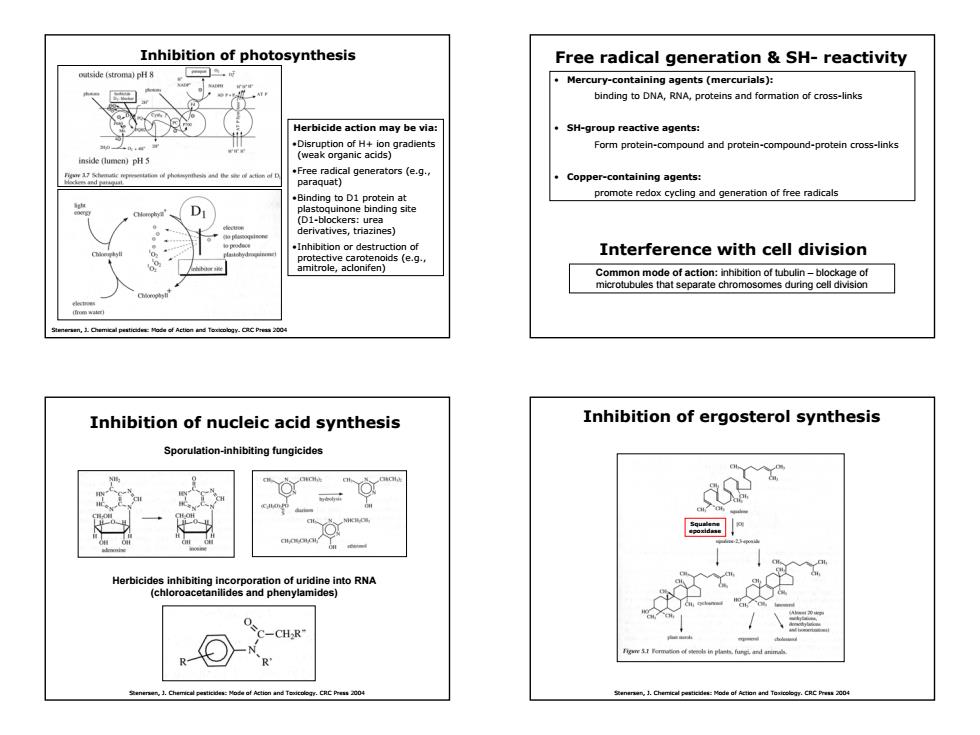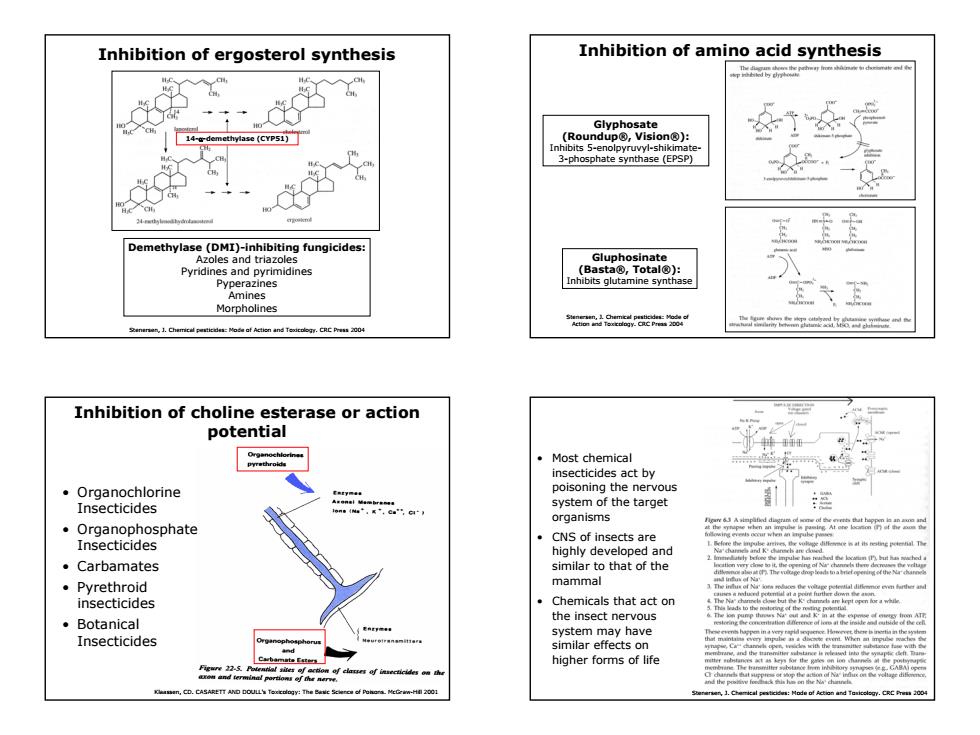
Pesticides are substances used to prevent,destroy, repel or mitigate any pest ranging from insects,animals and weeds to microorganisms such as fungi,molds, bacteria and viruses. insect killers(insecticides) mold and fungi killers(fungicides) Toxic Effects of Pesticides weed killers (herbicides) slug pellets(molluscicides) plant growth regulators bird and animal repellents rat and mouse killers(rodenticides) Pesticides help to manage and prevent pests that spread ga6taetpbenaeceuiangs,andotherpropet Pesticides help to manage and prevent pests that spread disease,that da Agricultural production has increased 82%in the past 30 years due to pesticides n.CD.CASARETT ANb DOULL's:The Sask Sdence of Poisens.MeGraw-Hil 200 Medical uses: Suppression of typhus epidemic in Italy,1943-1944 1943-72.8x109 ·Control of blindn fly that car Sales Control of Malaria in Africa,Middle East,and Asia by Herbicides 47.6% eliminating the mosquito populations Insecticides 29.4% Fungicides 17.4% Others 5.5% an,1.Chemical and CRC Press 200
1 Toxic Effects of Pesticides Pesticides are substances used to prevent, destroy, repel or mitigate any pest ranging from insects, animals and weeds to microorganisms such as fungi, molds, bacteria and viruses. • insect killers (insecticides) • mold and fungi killers (fungicides) • weed killers (herbicides) • slug pellets (molluscicides) • plant growth regulators • bird and animal repellents • rat and mouse killers (rodenticides) Pesticides help to manage and prevent pests that spread disease, that damage crops, buildings, and other property, and that are a public nuisance. Medical uses: • Suppression of typhus epidemic in Italy, 1943-1944 • Control of blindness in West Africa by killing the black fly that carried the disease • Control of Malaria in Africa, Middle East, and Asia by eliminating the mosquito populations Pesticides help to manage and prevent pests that spread disease, that damage crops, buildings, and other property, and that are a public nuisance. Agricultural production has increased 82% in the past 30 years due to pesticides Stenersen, J. Chemical pesticides: Mode of Action and Toxicology. CRC Press 2004 Klaassen, CD. CASARETT AND DOULL's Toxicology: The Basic Science of Poisons. McGraw-Hill 2001 World production (1995): 2.6x109 kg US production (1997): 0.54x109 kg World production of DDT (1943-74): 2.8x109 kg

Regulations(US): eBatae Vulnerability of Children Federal Insecticide,Fungicide, and Rodenticide Act(FIFRA) Greater exposure 2g出S别 On a body-weight:caloric consumption ratio Children are 2.5x adults.Diet less varied (fruit and milk) ·↑Hand to mouth activity montrngrnat nsible for Skin surface area per body weight is double and poultry h that of an adult ·↑Rate of respiration Food Quality Protection Act (1996) specia10-fodaietastconndeoher rnd hirn ☐□□Pesticide6 cycle(USA) Vulnerability of Children -图□口> Greater physiological susceptibility 门回国 Period of rapid development of nerve cells Loss of organ function can be permanently imprinted ·Absorption and↓elimination of pesticides Metabolizing enzymes not fully developed Figure 22-3.A schem Estimated cost to develop new pesticide product:$80 mln(1999)
2 Regulations (US): Federal Insecticide, Fungicide, and Rodenticide Act (FIFRA) Established in 1947 under USDA Turned over to the EPA in 1972 FDA retains authority over monitoring residues in foods USDA is responsible for monitoring residues in meat and poultry Food Quality Protection Act (1996) Special 10-fold safety factor and other precautions added to consider possible effects in infants and children Klaassen, CD. CASARETT AND DOULL's Toxicology: The Basic Science of Poisons. McGraw-Hill 2001 Vulnerability of Children Greater exposure • On a body-weight: caloric consumption ratio Children are 2.5x adults. Diet less varied (fruit and milk) • ↑ Hand to mouth activity • Skin surface area per body weight is double that of an adult • ↑ Rate of respiration Vulnerability of Children Greater physiological susceptibility • Period of rapid development of nerve cells • Loss of organ function can be permanently imprinted • ↑ Absorption and ↓ elimination of pesticides • Metabolizing enzymes not fully developed Klaassen, CD. CASARETT AND DOULL's Toxicology: The Basic Science of Poisons. McGraw-Hill 2001 Estimated cost to develop new pesticide product: $80 mln (1999)

Complexities of the Nomenclature:Example Modes of action of pesticides: Disturbance in energy production Chemical Name Inhibition of photosynthesis ) Free radical generation SH-group reactivity Interference with cell division Inhibition of nucleic acid synthesis Inhibition of enzymes: Ergosterol synthesis Amino acid synthesis 级4,ENT游 Varies Codes Chitin synthesis Cholinesterase Hormone-like and behavior-modifying agents 1.h des:Mode af Action and Teod ogr.CRE Press 2004 Disturbance in energy production Disturbance in energy production Site of Action Compounds Toic for Most animals C e-al Most animals (o ate) Rotenon Insects,fish B.O ic rgnm Most arganisms Naturally occurring compound ts.fis Highly toxic to fish them to CRC Ps 2004
3 Complexities of the Nomenclature: Example Stenersen, J. Chemical pesticides: Mode of Action and Toxicology. CRC Press 2004 • Disturbance in energy production • Inhibition of photosynthesis • Free radical generation & SH-group reactivity • Interference with cell division • Inhibition of nucleic acid synthesis • Inhibition of enzymes: Ergosterol synthesis Amino acid synthesis Chitin synthesis Cholinesterase • Hormone-like and behavior-modifying agents Modes of action of pesticides: Disturbance in energy production Naturally occurring compound Blocks electron transfer from NADH to ubiquinone in mitochondria Highly toxic to fish Stenersen, J. Chemical pesticides: Mode of Action and Toxicology. CRC Press 2004 Disturbance in energy production Stenersen, J. Chemical pesticides: Mode of Action and Toxicology. CRC Press 2004

Inhibition of photosynthesis Free radical generation SH-reactivity ()H 。d Mercury-containing agents(mercurials): binding to DNA,RNA,proteins and formation of cross-links Herbicide action may be via: SH-group reactive agents: Form protein-compound and protein-compound-protein cross-links inside (umen)pH5 pe8ga9eneaoseg Copper-containing agents: Binding to D1 protein at promote redox cycling and generation of free radicals e binding site derivatives,triazines) Inhibition or destruction of Interference with cell division 8mitoieaCoRir2ng"ts(e.g. Common mode of action:inhibition of tubulin-block microubules thatsparat hromomuing cllv Inhibition of nucleic acid synthesis Inhibition of ergosterol synthesis Sporulation-inhibiting fungicides ehloroacgnti Herbicides inhibitin idine int and ph RNA ides) C-CH,R' CRC Press 2004 and Te slegr.CRC 2004
4 Inhibition of photosynthesis Stenersen, J. Chemical pesticides: Mode of Action and Toxicology. CRC Press 2004 Herbicide action may be via: •Disruption of H+ ion gradients (weak organic acids) •Free radical generators (e.g., paraquat) •Binding to D1 protein at plastoquinone binding site (D1-blockers: urea derivatives, triazines) •Inhibition or destruction of protective carotenoids (e.g., amitrole, aclonifen) Free radical generation & SH- reactivity • Mercury-containing agents (mercurials): binding to DNA, RNA, proteins and formation of cross-links • SH-group reactive agents: Form protein-compound and protein-compound-protein cross-links • Copper-containing agents: promote redox cycling and generation of free radicals Interference with cell division Common mode of action: inhibition of tubulin – blockage of microtubules that separate chromosomes during cell division Inhibition of nucleic acid synthesis Sporulation-inhibiting fungicides Herbicides inhibiting incorporation of uridine into RNA (chloroacetanilides and phenylamides) Stenersen, J. Chemical pesticides: Mode of Action and Toxicology. CRC Press 2004 Inhibition of ergosterol synthesis Squalene epoxidase Stenersen, J. Chemical pesticides: Mode of Action and Toxicology. CRC Press 2004

Inhibition of ergosterol synthesis Inhibition of amino acid synthesis 女竹女层 nvvl-shikin 3-phosphate synthase(EPSP) Demethylase(DMI)-inhibiting fungicides: Azoles and triazoles : 基 Pyridines and pyrimidines Pyperazines bits gluta synthase 三 Morpholines o8a编 1.h des:Mode af Action and Teodedlogr.CRC Press 2004 Inhibition of choline esterase or action potential 。Most chemical insecticides act by 。Organochlorine poisoning the nervous Insecticides system of the target organisms ·Organophosphate Insecticides ·CNS of insects are highly developed and 。Carbamates similar to that of the ·Pyrethroid mammal insecticides ·Chemicals that act on ·Botanical the insect nervous Insecticides system may have similar effects on higher forms of life
5 Inhibition of ergosterol synthesis 14-α-demethylase (CYP51) Demethylase (DMI)-inhibiting fungicides: Azoles and triazoles Pyridines and pyrimidines Pyperazines Amines Morpholines Stenersen, J. Chemical pesticides: Mode of Action and Toxicology. CRC Press 2004 Inhibition of amino acid synthesis Glyphosate (Roundup®, Vision®): Inhibits 5-enolpyruvyl-shikimate- 3-phosphate synthase (EPSP) Gluphosinate (Basta®, Total®): Inhibits glutamine synthase Stenersen, J. Chemical pesticides: Mode of Action and Toxicology. CRC Press 2004 Inhibition of choline esterase or action potential • Organochlorine Insecticides • Organophosphate Insecticides • Carbamates • Pyrethroid insecticides • Botanical Insecticides Klaassen, CD. CASARETT AND DOULL's Toxicology: The Basic Science of Poisons. McGraw-Hill 2001 • Most chemical insecticides act by poisoning the nervous system of the target organisms • CNS of insects are highly developed and similar to that of the mammal • Chemicals that act on the insect nervous system may have similar effects on higher forms of life Stenersen, J. Chemical pesticides: Mode of Action and Toxicology. CRC Press 2004